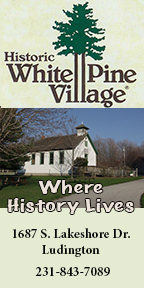
Naw-gone-koung, aka “Good John”
MC History Spotlight: Good John, Leading Thunder of the Ottawa.
MC History Spotlight is a weekly history column brought to you by Ludington Woods Living and Memory Care. Each week this column will feature a story from our county’s past.
By Rob Alway, Editor-in-Chief.
On the south side of Custer’s Riverside Cemetery, near the banks of the Pere Marquette River is a Native American burial ground. A sign marks the location of the grave of Naw-gone-koung, meaning “Leading Thunder,” who lived his life in what is now Mason County. He was known by the white settlers as “Good John.” By the 1880s, Good John was documented as the only survivor of the Ottawa who occupied this area before white settlers came. The grave sign states that Good John lived from 1788 to 1892. A published newspaper story put his birth year at 1807.
He was born in an Indian village near the mouth of the modern Pere Marquette River on the what we call the Buttersville Peninsula near the site of Historic White Pine Village in Pere Marquette Charter Township. His father, Gee-gush, died when Good John was 10- or 12-years-old.
He was a cousin of a chief named Sog-e-maw, who died about 1845. Published accounts say the village was located near where Burr Caswell built his home (Mason County’s first courthouse, which is on display at White Pine Village).
The village was abandoned in 1848. Good John made his way to Riverton Township where he homesteaded and farmed 40 acres. He later sold that land and homesteaded another 40 acres in Eden Township. This was likely in the 1850s, which would coincide with the building of an Indian school in 1859 2 1/2 miles south of Custer on what is now Custer Road. That school later became Resseguie School, according an article in the Mason County Historical Society’s 1980 history book.
 The school board consisted of three men, all Native Americans: “Good John” was moderator, John Smith, director, Joseph Donegan, assessor.”
The school board consisted of three men, all Native Americans: “Good John” was moderator, John Smith, director, Joseph Donegan, assessor.”
Good John was also documented as being a convert to Christianity. He joined the Methodist church and preached to his own people.
Good John may have been the last known of the “original” Ottawa people in the area, but he certainly wasn’t the only Indian. In 1857, members of the Ottawa, Pottawatamie and Chippewa tribes came to a reservation established in Mason County’s Custer and Eden townships and Oceana County’s Crystal and Elbridge townships. Two years previous, those Indians had surrendered their land along the Grand River near Grand Rapids, in accordance to a treaty.
The approximately 1,700 Indians came to the area via boat from Grand Haven to Pentwater (ironically, one of the boats, a steamer, was called “The Ottawa.”) Schools were established, including the future Resseguie School. Between 1857 and 1872, the U.S. government made payments to the Indians ranging from $13 to $75 annually. By an act of Congress, whites were allowed to settle in the reservation areas beginning in 1874. Many of the Indians homesteaded their lands and eventually sold them. Many of them are now buried in Custer Riverside Cemetery.
Ludington Woods Assisted Living and Memory Care, 502 N. Sherman St., Ludington, MI 49431; 231-845-6100; www.ludingtonwoods.com.
This story is copyrighted © 2019, all rights reserved by Media Group 31, LLC, PO Box 21, Scottville, MI 49454. No portion of this story or images may be reproduced in any way, including print or broadcast, without expressed written consent.































.png)


































